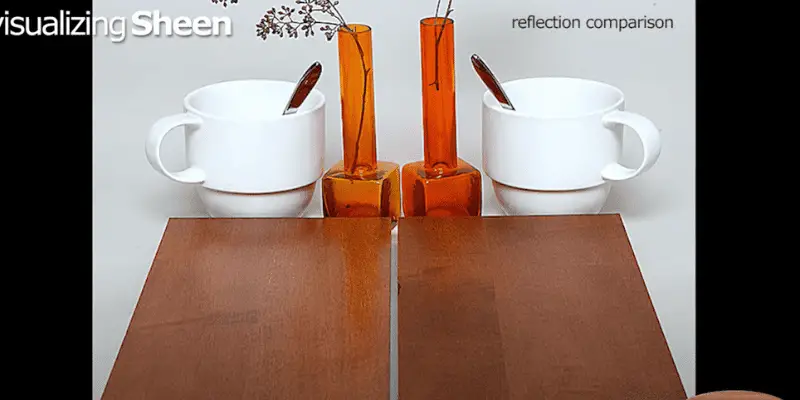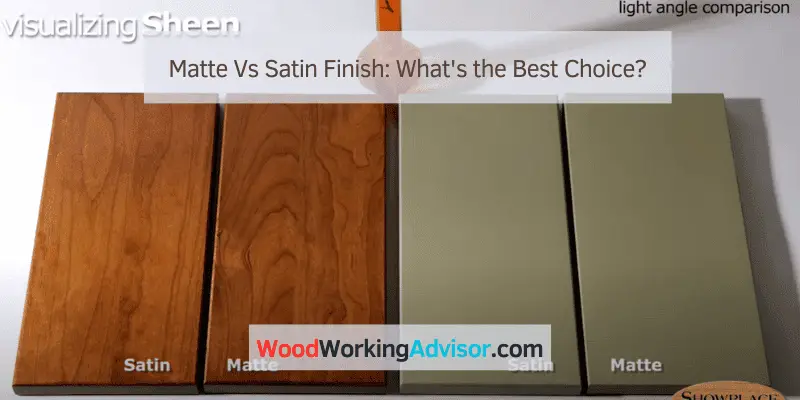Matte and satin finishes differ in sheen level, with matte having no shine and satin having a low sheen. These finishes create distinct looks and have unique properties.
Matte finishes offer a flat, non-reflective appearance, ideal for hiding imperfections, while satin finishes provide a subtle shine and are more durable. The choice between matte and satin finishes depends on the desired aesthetic and practical considerations for the specific application.
Understanding the characteristics and differences between these finishes allows for informed decisions when selecting the ideal finish for a project. Whether it’s for interior design, automotive coatings, or woodworking, the decision to use matte or satin finish impacts the overall visual appeal and functionality of the surface. We will explore the contrasts between matte and satin finishes to help you make informed choices based on your project’s requirements.
The Difference Between Matte And Satin Finishes
When it comes to choosing the perfect finish for your home decor or furniture, understanding the difference between matte and satin finishes is crucial. Each finish offers unique characteristics that can significantly impact the overall aesthetic and durability of the surface. From the subtle sheen of matte to the soft glow of satin, knowing the distinct features of each finish can help you make an informed decision for your next project.
Characteristics Of Matte Finish
A matte finish is characterized by its non-reflective, velvety appearance. It has a smooth, flat texture that absorbs light, creating a subtle, elegant look. The lack of shine in a matte finish helps to conceal imperfections, making it a popular choice for walls, furniture, and decorative items. Its understated appeal adds a contemporary and sophisticated touch to any surface.
Characteristics Of Satin Finish
A satin finish, on the other hand, offers a gentle sheen that reflects light, creating a silky, smooth texture. It falls between the matte and gloss finishes on the sheen spectrum, providing a delicate luster without being too shiny. This finish is known for its durability and resilience, making it suitable for high-traffic areas and surfaces that require regular cleaning. The soft glow of a satin finish adds a touch of elegance and warmth to any space.

Pros And Cons Of Matte Finish
Choosing between a matte and satin finish can have a significant impact on the appearance and performance of a surface. Understanding the pros and cons of matte finish is crucial in making an informed decision. Matte finish offers a unique aesthetic and is increasingly popular in various applications. However, there are certain limitations that need to be considered. Let’s delve into the advantages and limitations of matte finish to help you make an informed decision.
Advantages Of Matte Finish
- Elegant Appearance: Matte finish provides a sophisticated and elegant aesthetic, adding a touch of luxury to surfaces.
- Conceals Imperfections: It effectively hides imperfections such as scratches and fingerprints, making it a suitable choice for high-traffic areas.
- Reduced Glare: The lack of reflective properties in matte finishes reduces glare, making it ideal for use in areas with natural or artificial lighting.
- Easy Maintenance: Matte finishes are easier to maintain as they tend to show fewer smudges and watermarks compared to glossy finishes, requiring less frequent cleaning.
Limitations Of Matte Finish
- Susceptible to Stains: Matte finishes may show water and oil stains prominently due to their porous nature, requiring careful maintenance to keep the surface clean.
- Less Reflective: While reduced glare is an advantage, matte finishes also lack the light-reflective properties of high gloss finishes, which may impact the overall brightness of a room.
- Limited Color Options: Some colors may appear less vibrant on matte finishes compared to glossy surfaces, limiting the range of available color options.
- Scratch Sensitivity: Matte finishes are more susceptible to visible scratches and abrasions compared to glossier counterparts, requiring careful handling to maintain the surface’s appearance.
Pros And Cons Of Satin Finish
Satin finish offers a smooth and subtle sheen, providing a luxurious look without being overpowering. It minimizes the appearance of imperfections and is easier to clean. However, it may not have the same durability as a matte finish and can show fingerprints and smudges more visibly.
Advantages Of Satin Finish
The satin finish is a popular choice for many homeowners due to its unique properties. Let’s delve into some of the benefits of opting for a satin finish.
- Low sheen: Satin finishes offer a subtle, low sheen, providing a soft and elegant aesthetic to surfaces.
- Conceals imperfections: This finish is adept at concealing minor imperfections, making it a suitable choice for walls and ceilings with minor flaws.
- Durability: Satin finishes are relatively durable, making them suitable for high-traffic areas in homes.
- Easy to clean: It’s more washable than flat or matte finishes, making it easier to maintain and more practical for areas prone to spills or stains.
Limitations Of Satin Finish
While satin finishes offer many advantages, it’s essential to consider their limitations to make an informed decision.
- Visible application marks: Due to the slight sheen, satin finishes can highlight application marks and flaws, requiring careful application.
- Not ideal for heavily damaged surfaces: In cases of heavily damaged walls or ceilings, a satin finish may not effectively conceal the imperfections.
- Price: Satin finishes often come at a higher price point compared to flat or matte finishes, impacting budget considerations.
How To Choose The Best Finish
If you’re in the process of choosing a finish for your next home improvement project, you might find yourself contemplating between a matte or satin finish. Both finishes have their own unique qualities that can significantly impact the overall look and feel of a space. Understanding the differences between the two and the factors to consider when choosing the best finish for your needs is essential. Let’s delve into the details on how to select the optimal finish for your project.
Factors To Consider
When deciding between a matte and satin finish, there are several key factors to consider that will help guide your choice:
- Sheen Level: Matte finishes have a lower sheen level than satin finishes. If you prefer a more subtle and muted appearance, a matte finish may be the better option. On the other hand, if you’re looking for a soft sheen that reflects light, a satin finish may be the ideal choice.
- Durability: Consider the level of durability you require for the space. Matte finishes are great at hiding imperfections and are generally more resistant to scratches and scuffs. Satin finishes offer a slightly higher level of durability and can withstand mild cleaning, making them suitable for high-traffic areas.
- Surface Application: Evaluate the surface where the finish will be applied. Matte finishes are commonly used for walls and ceilings, providing a smooth and elegant appearance. Satin finishes are versatile and can be applied to various surfaces, including trim, doors, and cabinets, adding a touch of sophistication to these elements.
- Lighting Conditions: Assess the lighting conditions in the room. Matte finishes can help minimize the appearance of imperfections and glare, making them suitable for spaces with natural or harsh lighting. Satin finishes can subtly reflect light, making them a good choice for rooms with limited natural light.
Final Considerations
As you weigh the factors for choosing between a matte and satin finish, remember that personal preference and the intended aesthetic of the space play a significant role in the decision-making process. Consider obtaining samples of both finishes and testing them in the intended space to observe how they interact with the lighting and overall ambiance. By carefully considering these factors, you’ll be equipped to make an informed decision on selecting the perfect finish for your project.
Frequently Asked Questions On Matte Vs Satin Finish
What Is The Difference Between Matte And Satin Finish?
Matte finish has a flat appearance, while satin finish has a slight sheen. Matte finish hides imperfections, while satin finish offers some gloss. Both finishes are durable and easy to clean.
Which Rooms Are Best Suited For Matte Finish?
Matte finish is ideal for bedrooms, living rooms, and areas with low traffic. Its subtle texture helps to create a cozy and inviting atmosphere.
Is Satin Finish Suitable For High-traffic Areas?
Yes, satin finish is perfect for high-traffic areas like kitchens and hallways. Its subtle shine adds a touch of elegance while being easy to clean and maintain.
Can Matte Or Satin Finish Be Used On Ceilings?
Both matte and satin finish can be used on ceilings. Matte finish minimizes glare and adds depth, while satin finish offers a soft glow to brighten up the space.
Conclusion
In choosing between a matte and a satin finish, it ultimately boils down to personal preference and the specific needs of your space. Both finishes offer unique characteristics that can enhance the aesthetics of your home. Consider the lighting, the style of the room, and the level of maintenance required to make the best decision.
Ultimately, the choice is yours!



4 thoughts on “Matte Vs Satin Finish: What’s the Best Choice?”